Detection and diagnostic value of urine leucine-rich α-2-glycoprotein in children with suspected acute appendicitis
- PMID: 22305331
- PMCID: PMC3726720
- DOI: 10.1016/j.annemergmed.2011.12.015
Detection and diagnostic value of urine leucine-rich α-2-glycoprotein in children with suspected acute appendicitis
Abstract
Study objective: Previously, we used a proteomics approach for the discovery of new diagnostic markers of acute appendicitis and identified leucine-rich α-2-glycoprotein (LRG) that was elevated in the urine of children with acute appendicitis and enriched in diseased appendices. Here, we sought to evaluate the diagnostic utility of enzyme-linked immunosorbent assay (ELISA) of urine LRG in a blinded, prospective, cohort study of children being evaluated for acute abdominal pain.
Methods: Urine LRG concentration was measured with a commercially available LRG ELISA and selected ion monitoring mass spectrometry. Urine LRG test performance was evaluated blindly against the pathologic diagnosis and histologic grade of appendicitis.
Results: Urine LRG was measured in 49 patients. Mean urine LRG concentration measured with commercial LRG ELISA was significantly elevated in patients with acute appendicitis but exhibited an interference effect. Direct measurements using selected ion monitoring mass spectrometry demonstrated that LRG was elevated more than 100-fold in patients with acute appendicitis compared with those without, with the receiver operating characteristic area under the curve of 0.98 (95% confidence interval 0.96 to 1.0). Among patients with acute appendicitis, elevations of urine LRG measured with ELISA and selected ion monitoring mass spectrometry correlated with the histologic severity of appendicitis.
Conclusion: Urine LRG ELISA allows for discrimination between patients with and without acute appendicitis but exhibits limited accuracy because of immunoassay interference. Direct measurements of urine LRG with selected ion monitoring mass spectrometry demonstrate superior diagnostic performance. Development of a clinical-grade urine LRG assay is needed to advance the diagnostic accuracy of clinical evaluations of appendicitis.
Copyright © 2011. Published by Mosby, Inc.
Figures

References
-
- Schneider C, Kharbanda A, Bachur R. Evaluating appendicitis scoring systems using a prospective pediatric cohort. Ann Emerg Med. 2007;49(6):778–784. e771. 784. - PubMed
-
- Doria AS, Moineddin R, Kellenberger CJ, Epelman M, Beyene J, Schuh S, et al. US or CT for Diagnosis of Appendicitis in Children and Adults? A Meta-Analysis. Radiology. 2006;241(1):83–94. - PubMed
-
- Howell JM, Eddy OL, Lukens TW, Thiessen ME, Weingart SD, Decker WW. Clinical policy: Critical issues in the evaluation and management of emergency department patients with suspected appendicitis. Ann Emerg Med. 2010;55(1):71–116. - PubMed
Publication types
MeSH terms
Substances
Grants and funding
LinkOut - more resources
Full Text Sources
Medical
Miscellaneous

